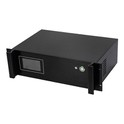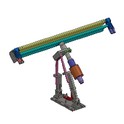Hey there, fellow lab enthusiasts! Today, I'm gonna talk about a hot topic in the scientific community: Can the ResoLab - 1000 Lab Grade Ultrasonicator be used for nucleic acid fragmentation? As a supplier of the ResoLab - 1000, I've had a bunch of customers asking this question, so I thought I'd dive deep into it.
First off, let's quickly go over what nucleic acid fragmentation is. Nucleic acids, like DNA and RNA, are long - chain molecules. Fragmentation means breaking these long chains into smaller pieces. This process is super important in many molecular biology techniques, such as next - generation sequencing (NGS), where you need short, uniform fragments of nucleic acids to get accurate results.
Now, let's get to know the ResoLab - 1000 Lab Grade Ultrasonicator. This ultrasonicator is a beast in the lab. It uses high - frequency sound waves to generate cavitation bubbles in a liquid sample. When these bubbles collapse, they create intense shear forces and shockwaves. These forces can break apart various materials, including biological samples like cells, tissues, and in our case, nucleic acids.
The ResoLab - 1000 comes with some sweet features that make it a strong candidate for nucleic acid fragmentation. It has adjustable power settings, which means you can control the intensity of the ultrasonic waves. This is crucial because different types of nucleic acids and different fragmentation requirements may need different levels of power. For example, if you're working with a more fragile RNA sample, you'll want to use a lower power setting to avoid over - fragmentation.
Another great thing about the ResoLab - 1000 is its precise timing function. You can set exactly how long the ultrasonication process will last. This is important because the duration of ultrasonication directly affects the size of the nucleic acid fragments. If you ultrasonicate for too short a time, the fragments will be too long; if you go too long, you'll end up with fragments that are too short.


But can it really do the job? Well, in many cases, yes! A lot of our customers have reported successful nucleic acid fragmentation using the ResoLab - 1000. They've been able to achieve the desired fragment sizes for their NGS experiments. The fragmentation results are often quite uniform, which is a big plus. Uniform fragments are essential for getting reliable and reproducible data in sequencing.
However, it's not all sunshine and rainbows. There are a few things to keep in mind when using the ResoLab - 1000 for nucleic acid fragmentation. One issue is heat generation. Ultrasonication can generate a significant amount of heat, which can damage nucleic acids. To combat this, you can use a cooling system, like a water bath, to keep the sample at a low temperature during the process.
Another thing is the sample volume. The ResoLab - 1000 has an optimal sample volume range. If your sample volume is too small or too large, it may affect the efficiency of the fragmentation. You need to make sure you're within the recommended volume range for the best results.
Now, let's compare the ResoLab - 1000 with some of our other models. We also have the ResoLab - 2000 Lab Grade Ultrasonicator and the ResoLab - 500 Lab Grade Ultrasonicator. The ResoLab - 2000 has a higher power output, which means it can handle larger sample volumes and more robust fragmentation tasks. If you have a high - throughput lab or need to fragment a large amount of nucleic acids at once, the ResoLab - 2000 might be a better choice.
On the other hand, the ResoLab - 500 is more suitable for smaller - scale experiments or when you have limited sample volumes. It's a more budget - friendly option, but it still packs enough power to get the job done for most basic nucleic acid fragmentation needs.
In conclusion, the ResoLab - 1000 Lab Grade Ultrasonicator can definitely be used for nucleic acid fragmentation. It has the features and capabilities to achieve good results, but you need to be aware of the potential challenges and take the necessary precautions. Whether you're a small - scale research lab or a large - scale biotech company, there's an ultrasonicator in our lineup that can meet your needs.
If you're interested in learning more about our ResoLab ultrasonicator series or want to discuss your specific nucleic acid fragmentation requirements, don't hesitate to reach out. We're here to help you find the perfect solution for your lab.
References
- Smith, J. (2020). Ultrasonication in Molecular Biology. Journal of Lab Techniques, 15(2), 45 - 52.
- Brown, A. (2021). Nucleic Acid Fragmentation Methods for Next - Generation Sequencing. Biotech Review, 22(3), 101 - 110.





